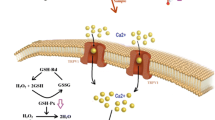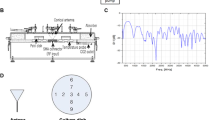Summary
This study examined the impact of 935MHz phone-simulating electromagnetic radiation on embryo implantation of pregnant mice. Each 7-week-old Kunming (KM) female white mouse was set up with a KM male mouse in a single cage for mating overnight after induction of ovulation. In the first three days of pregnancy, the pregnant mice was exposed to electromagnetic radiation at low-intensity (150 μW/cm2, ranging from 130 to 200 μW/cm2, for 2- or 4-h exposure every day), mid-intensity (570 μW/cm2, ranging from 400 to 700 μW/cm2, for 2- or 4-h exposure every day) or high-intensity (1400 μW/cm2, ranging from 1200 to 1500 μW/cm2, for 2- or 4-h exposure every day), respectively. On the day 4 after gestation (known as the window of murine embryo implantation), the endometrium was collected and the suspension of endometrial glandular cells was made. Laser scanning microscopy was employed to detect the mitochondrial membrane potential and intracellular calcium ion concentration. In high-intensity, 2- and 4-h groups, mitochondrial membrane potential of endometrial glandular cells was significantly lower than that in the normal control group (P<0.05). The calcium ion concentration was increased in low-intensity 2-h group but decreased in high-intensity 4-h group as compared with the normal control group (P<0.05). However, no significant difference was found in mitochondrial membrane potential of endometrial glandular cells between low- or mid-intensity groups and the normal control group, indicating stronger intensity of the electromagnetic radiation and longer length of the radiation are required to inflict a remarkable functional and structural damage to mitochondrial membrane. Our data demonstrated that electromagnetic radiation with a 935-MHz phone for 4 h conspicuously decreased mitochondrial membrane potential and lowered the calcium ion concentration of endometrial glandular cells. It is suggested that high-intensity electromagnetic radiation is very likely to induce the death of embryonic cells and decrease the chance of their implantation, thereby posing a high risk to pregnancy.
Similar content being viewed by others
References
Baan R, Gross Y, Lauby-Secretan B, et al. Carcinogenicity of radiofrequency electromagnetic fields. Lancet Oncol, 2011,12(7):624–626
Merhi ZO. Challenging cell phone impact on reproduction: A review. J Assist Reprod Genet, 2012,29(4):293–297
Batellier F, Couty I, Picard D, et al. Effects of exposing chicken eggs to a cell phone in “call” position over the entire incubation period. Theriogenology, 2008,69(6): 737–745
Zareen N, Khan MY, Minhas LA. Dose related shifts in the developmental progress of chick embryos exposed to mobile phone induced electromagnetic fields. J Ayub Med Coll Abbottabad, 2009,21(1):130–134
Kesari KK, Behari J. Effects of microwave at 2.45 GHz radiations on reproductive system of male rats. Toxicol Environ Chem, 2010,92(6): 1135–1147
Gutschi T, Mohamad Al-Ali B, Shamloul R, et al. Impact of cell phone use on men’s semen parameters. Andrologia, 2011,43(5): 312–316
Otitoloju AA, Obe IA, Adewale OA, et al. Preliminary study on the induction of sperm head abnormalities in mice, Mus musculus, exposed to radiofrequency radiations from global system for mobile communication base stations. Bull Environ Contam Toxicol, 2010,84(1): 51–54
Pilger A, Ivancsits S, Diem E, et al. No effects of intermittent 50 Hz EMF on cytoplasmic free calcium and on the mitochondrial membrane potential in human diploid fibroblasts. Radiat Environ Biophys, 2004,43(3): 203–207
Imai N, Kawabe M, Hikage T, et al. Effects on rat testis of 1.95-GHz W-CDMA for IMT-2000 cellular phones. Syst Biol Reprod Med, 2011,57(4):204–209
Falzone N, Huyser C, Franken DR, et al. Mobile phone radiation does not induce pro-apoptosis effects in human spermatozoa. Radiat Res, 2010,174(2):169–176
Kadenbach B, Arnold S, Lee I, et al. The possible role of cytochrome c oxidase in stress-induced apoptosis and degenerative diseases. J Biochim Biophys Acta-Bioenerg, 2004,1655(1–3):400–408
Breckenridge DG, Stojanovic M, Marcellus RC, et al. Caspase cleavage product of BAP31 induces mitochondrial fission through endoplasmic reticulum calcium signals, enhancing cytochrome c release to the cytosol. J Cell Biol, 2003,160(7):1115–1127
Oral B, Guney M, Ozguner F, et al. Endometrial apoptosis induced by a 900-MHz mobile phone: preventive effects of vitamins E and C. Adv Ther, 2006,23(6):957–973
Paulraj R, Behari J. The effect of low level continuous 2.45 GHz waves on enzymes of developing rat brain. Electromagn Biol Med, 2002,21(3): 221–231
Paulraj R, Behari J, Rao AR. Effect of amplitude modulated RF radiation on calcium ion efflux and ODC activity in chronically exposed rat brain. Indian J Biochem Biophys, 1999,36(5):337–340
Csordas G, Renken C, Varnai P, et al. Structural and functional features and significance of the physical linkage between ER and mitochondria. J Cell Biol, 2006,174(7):915–921
De Brito OM, Scorrano L. Mitofusin 2 tethers endoplasmic reticulum to mitochondria. Nature, 2008, 456(7222):605–610
Hayashi T, Rizzuto R, Hajnoczky G, et al. MAM: more than just a housekeeper. Trends Cell Biol, 2009,19(2): 81–88
Scorrano L, Oakes SA, Opferman JT, et al. BAX and BAK regulation of endoplasmic reticulum Ca2+: a control point for apoptosis. Science, 2003,300(5616): 135–139
Walter L, Hajnoczky G. Mitochondria and endoplasmic reticulum: the lethal interorganelle cross-talk. J Bioenerg Biomembr, 2005,37(3):191–206
Yang J, Zhang YZ, Liu WH. Effect of 935 MHz microwave electromagnetic fields on meiotic maturation of mouse oocytes. Med J Wuhan Univer (Chinese), 2008,29(4):519–523
Yang J, Zhang YZ, Liu WH. Effect of 935 MHz microwave electromagnetic fields on the embryo implantation of mouse. Reprod Contracept (Chinese), 2008,28(2):80–83
Perry SW, Norman JP, Barbieri J, et al. Mitochondrial membrane potential probes and the proton gradient: a practical usage guide. Biotechniques, 2011,50(2):98–102
Susa M, Pavicic’ I. Effects of radiofrequency electromagnetic fields on mammalian spermatogenesis. Arh Hig Rada Toksikol, 2007,58(4):449–459
Aitken RJ, Bennetts LE, Sawyer D, et al. Impact of radio frequency electromagnetic radiation on DNA integrity in the male germline. Int J Androl, 2005,28(3):171–179
Falzone N, Huyser C, Fourie F, et al. In vitro effect of pulsed 900MHz GSM radiation on mitochondrial membrane potential and motility of human spermatozoa. Bioelectromagnetics, 2008,29(4):268–276
Zhao TY, Zou SP, Knapp PE. Exposure to cell phone radiation up-regulates apoptosis genes in primary cultures of neurons and astrocytes. J Neurosci lett, 2007,412(1): 34–38
Zhang H, Zhang J, Chen Y, et al. Influence of intracellular Ca2+, mitochondria membrane potential, reactive oxygen species, and intracellular ATP on the mechanism of microcystin-LR induced apoptosis in Carassius auratus lymphocytes in vitro. Environ Toxicol, 2007,22(6): 559–564
Carafoli E. Calcium-a universal carrier of biological signals. FEBS J, 2005,272(5):1073–1089
Amat A, Rigau J, Waynant RW, et al. The electric field induced by light can explain cellular responses to electromagnetic energy: A hypothesis of mechanism. J Photochem Photobiol B, 2006,82(2):152–160
Xia HJ, Yang G. Inositol 1, 4, 5-trisphosphate 3-kinases: functions and regulations. Cell Res, 2005,15(2):83–91
Qin YH, Li TD, Sheng H. Protective effect of naloxone on mitochondrial membranal potential of hypoxic myocardial cells and apoptosis. J Clin Rehabil Tissue Engineering Res (Chinese), 2007,11(8):1573–1576
Shi JH, Ju Q, Yin XP, et al. The effect of Hydrochloride small fold on intracellular free calcium and mitochondrial membrane potential of the base HaCaT. Chin J Dermatol (Chinese), 2005,38(2):105–107
Apáti A, Jánossy J, Brózik A, et al. Effects of Intracellular Calcium on Cell Survival and the MAPK Pathway in a Human Hormone-Dependent Leukemia Cell Line (TF-1). JAnn N Y Acad Sci, 2003,1010(1):70–73
Rao VS, Titushkin IA, Moros EG, et al. Non-thermal effects of radiofrequency-field exposure on calcium dynamics in stem cell-derived neuronal cells: elucidation of calcium pathways. Radiat Res, 2008,169(3):319–329
Zhao YL, Song JP, Yang YH, et al. Effect of microwave irradiation of different densities on Ca2+, Mg2+-ATPase activity of mouse brain. Chin J Aerospace Med, 2000,11(2): 101–104
Philippova TM, Novoselov VI, Alekseev SI. Influence of microwaves on different types of receptors and the role of peroxidation of lipids on receptor-protein shedding. Bioelectromagnetics, 1994,15(3):183–192
Hossmann KA, Hermann DM. Effects of electromagnetic radiation of mobile phones on the central nervous system. Bioelectromagnetics, 2003,24(1):49–62
Paulraj R, Behari J. Radio frequency radiation effects on protein kinase C activity in rats’ brain. Mutat Res, 2004,545(1–2):127–130
Bauréus KCL, Sommarin M, Persson BRR, et al. Interaction between weak low frequency magnetic fields and cell membranes. Bioelectromagnetics, 2003,24(6): 395–402
Author information
Authors and Affiliations
Corresponding author
Additional information
This work was supported by the National Natural Science Foundation of China (No. 30670509).
Rights and permissions
About this article
Cite this article
Liu, W., Zheng, X., Qu, Z. et al. Effect of 935-MHz phone-simulating electromagnetic radiation on endometrial glandular cells during mouse embryo implantation. J. Huazhong Univ. Sci. Technol. [Med. Sci.] 32, 755–759 (2012). https://doi.org/10.1007/s11596-012-1030-6
Received:
Published:
Issue Date:
DOI: https://doi.org/10.1007/s11596-012-1030-6




